Big data seems to touch every industry, and it’s come to sports in a big way. It could be argued baseball and football pioneered analytics in the modern age, but the NBA wants to perfect it. Machine learning is about to come to the sport of basketball in a big way, as the ruleset and gameplay shift towards the long ball.

It’s not enough to sink the 3-point shot, though, in a league that is increasingly favoring defensive play. Big data will help coaches and players re-think their approach to the hoop, and could alter the fundamentals of the game. We might see new and exciting ideas crunching the data from years past to see what works and why.
Machine Learning and VR
The growth of VR corresponds with the growth of machine learning thanks to a single piece of equipment: the GPU. The graphics processing unit is one of the most sought-after pieces of hardware as computing steps into overdrive to crunch ever-expanding data sets into something actionable.
Two concepts are seeing real-world applications. The first is that major sports leagues like the NBA are recreating existing scenarios in VR to improve fundamental baselines of a player’s performance. Making players run through virtual drills does more than improving the mental game, as they interact with and study under coaching staff.
The second is to analyze the data left behind in those interactions, and in real-world scenarios. What good is a baseline if we cannot measure that against a live performance?
The NBA wants a big push into technology over the next few years. They already use it to train referees and provide top-notch fan experiences. Next, they want to look at how teams can benefit from the wealth of data the game generates over time.
Areas for Improvement
The teams need set goals for machine learning to be effective. They can start with looking at a player’s shot percentage, or the number of successful passes, but granular approaches to data uncover strategies and other ways to gain an edge in play.
Everything begins with parsing this data into meaningful chunks.
Forecasting Momentum
NBA teams could look at the characteristics that help build momentum. We know intuitively that scoring well plays a role, but there are small openings created when teams perform well. If the offense feels too fluid to stop, for instance, players become demoralized and feel less of an urge to apply themselves. Machine learning could help analyze passing lanes, specific player interactions and collate those ideas with shot and game clocks to find out when teams truly feel the pressure.
Assets and Interactions
Managing players is the coach’s fundamental role, and machine learning can help provide greater insight into who works well together. It might help us look at which players interact best by micro-analyzing successful plays, or by viewing how two players serve to split the defense and set up those field goals.
Machine learning also helps us uncover unexpected use cases or interactions. It’s how we know that the three-point game has dramatically eclipsed the short and mid game in the past decade of play.
Strategies
The reason the midgame is dying a slow death is that the ratio of points to shots is too low. Teams are able to improve their points ratio by increasing the score they earn per shot they take. But there is time stopping strategies that can be analyzed as well. Looking at a team’s fouls for the year could reveal both when and how that team draws fouls and how to use that valuable time, and free throwing opportunity, to their advantage.
Final Thoughts

This is still new territory for every sports league, and one of the big revelations that has come from data usage is that we don’t know what we don’t know. Sometimes the data may lead a team down a path no one had thought to explore before.
We also run the risk of over-analyzing the game and expecting past results to repeat themselves. Big data doesn’t change the game because it provides a clear path forward. It alters the game because teams can look analytically at their strategies and create real tests and plays with measurable outcomes.
Definitely, expect the game to change to long ball, but watch who defense uses to try and stop the play and the approaches they take. Unexpected plays may feel random but could be the result of a heavy study into the analytics of the game.


